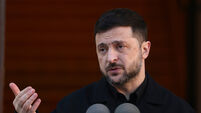Freed Guantanamo prisoner head of Yemen al-Qaida
A freed Guantanamo Bay terror detainee has re-emerged as an al-Qaida commander in Yemen, the US said today.
The confirmation that Said Ali al-Shihri was now leading a Yemeni branch of Osama bin Laden’s terror network highlights the difficulty US president Barack Obama faces in his efforts to close the Cuba detention centre and decide the fates of its captives.
In a video posted on a militant-leaning website, al-Shihri, who was jailed at Guantanamo for six years after his capture in Pakistan, said his detention only hardened his resolve to pursue holy war.
“By Allah, imprisonment only increased our persistence in our principles for which we went out, did jihad for, and were imprisoned for,” he said.
It was the second time this week a reference to al-Shihri has shown up on the website. He was mentioned in an online magazine on January 19 with a reference to his prisoner number at Guantanamo, 372.
Al-Shihri was released by the US in 2007 to the Saudi government for rehabilitation. But this week a publication posted on the site said he was now the top deputy in “al-Qaida in the Arabian Peninsula”, a Yemeni offshoot of the terror group. The group has been implicated in several attacks on the US Embassy in Yemen’s capital Sana.
The second announcement from the site came the day after Mr Obama signed an executive order directing the closure of the prison at the US naval base within a year.
The website announcement which carried the video post of al-Shihri also included a video of a second militant who identified himself as Abu al-Hareth Muhammad al-Oufi and claimed he had also been a Guantanamo captive, later released.
Both videos were partially translated by SITE Intel Group, an organisation that monitors extremist websites.
Al-Shihri is one of a small number of deputies in the Yemeni group, a US counter-terror official said. US officials were not available to verify the claims of the second militant on the video.
A key question facing Mr Obama’s new administration is what to do with the 245 prisoners still confined at Guantanamo. That means finding new detention facilities for hardcore prisoners while trying to determine which detainees are harmless enough to release.
According to the Pentagon, at least 18 former Guantanamo detainees have “returned to the fight” and 43 others are suspected of resuming terrorist activities. Pentagon spokesman Geoff Morrell would not identify the former detainees or say what their terrorist activities were.
It is unclear whether al-Shihri’s name would be a new addition to that list of 61.
The militant website referred to al-Shihri under his terror alias Abu Sayyaf al-Shihri. The video refers to him as “Abu Sufyan al-Azdi al-Shahri”.
An online magazine posted to the internet site said al-Shihri was the group’s second-in-command in Yemen. “He managed to leave the land of the two shrines (Saudi Arabia) and join his brothers in al Qaida,” the statement said.
Included in the site’s material was a message to Yemen’s populace from al-Qaida figure Ayman al-Zawahiri, bin Laden’s deputy.
According to Pentagon documents, al-Shihri was stopped at a Pakistani border crossing in December 2001 with injuries from an air strike and recovered at a hospital in Quetta for a month and a half. Within days of leaving the hospital, he became one of the first detainees sent to Guantanamo.
He allegedly travelled to Afghanistan two weeks after the September 11 2001 attacks, provided money to other fighters and trained in urban warfare at a camp north of Kabul, according to a summary of the evidence against him from US military review panels at Guantanamo Bay.
An alleged travel co-ordinator for al-Qaida, he was also accused of meeting extremists in Mashad, Iran, and briefing them on how to enter Afghanistan.
Al-Shihri, however, said he travelled to Iran to buy carpets for his store in Riyadh. He said he felt bin Laden had no business representing Islam, denied any links to terrorism and expressed interest in rejoining his family in Saudi Arabia.
Yemen is rapidly re-emerging as a terrorist battleground and potential base of operations for al Qaida and is a main concern for US counter-terrorism officials.
Al-Qaida in Yemen conducted an “unprecedented number of attacks” last year and was likely to be a launching pad for attacks against Saudi Arabia, outgoing CIA director Michael Hayden said in November.













